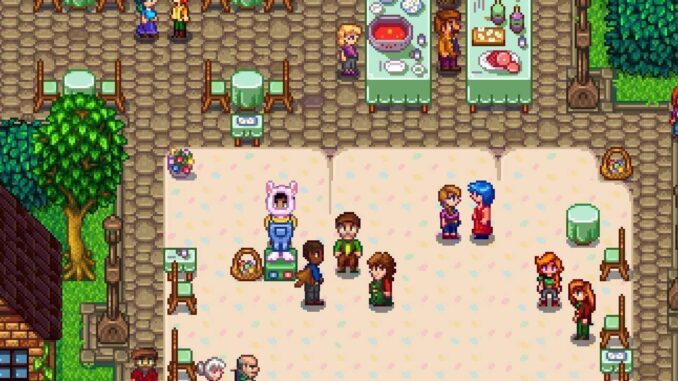
This guide will teach you the basics and more advanced features of farming and will help you level up your farming skill, one of the easiest and cheapest ways to make money in Stardew Valley.
Farm Maps
Getting Started in Stardew you have a lot of options for Farm Maps, for farming your best option is Standard Farm as this gives you the most tillable land and a full 63×31 rectangle (1953 tiles) of uninterrupted land, if you are playing multiplayer this is still probably the best map as the other maps whilst useful don’t provide a massive boost for the other players following other professions and farming is one of the easiest risk free ways to make money.
Spring
Getting spring right is your first priority, you want to save as much money as you can for Summer, following my guide below you can save yourself about 3000g for summer which you can use to set yourself up for a blueberry farm that will net you about 1800g per harvest, so here’s my Spring Plan:
Spring 101
- Day 1: Clear Farm until 9am, buy 8 Bean Seeds from Pierre, plant Parsnips and Beans.
- Day 5: Parsnips Grown, sell them.
- Day 6: Make roughly 500, go to the mine until you get to floor 5 with at least 1 coal (or get lucky when clearing the farm out) make a scarecrow and buy 7 Cauliflower seeds and plant them.
- Day 11: Beans Grown, sell them.
- Day 12: make roughly 300, save it.
- Day 13: Egg Festival, buy at least 1 Strawberry seed as this is the only time we can get them (we can buy 3) don’t plant them, save them for Greenhouse or next Spring when we should have a Seed Machine.
- Day 14: Beans regrow, sell them.
- Day 15: make roughly 300, save it.
- Day 17: Beans Regrow, sell them.
- Day 18: make roughly 300, cauliflower grows.
- Day 19: make roughly 1000, if RNG has been kind to you, you should have about 2000 gold now, buy 10 fertilizer and 20 Potato seeds plant them.
- Day 20: Beans regrow.
- Day 23: Beans regrow.
- Day 25: Potato grown.
- Day 26: make 2000, final bean regrow, farming for spring is done, spend remaining days in the mines, foraging or fishing or clearing the rest of the farm and sell any produce you have made that you aren’t saving for the Bundles.
By the end of spring you should have hit level 3 farming which is important for choosing your next focus which is your farm plan and what you will specialise in as a farmer.
Farm Plan and Terraforming
Planning your farm in advance is one of the most important things to do, while you are waiting for things to grow in Spring you should be clearing your farm of all its junk and preparing for the future, you also want to think about what type of Farm your farm is going to be, I have 3 routes for farming which is Tiller, Rancher and Bee Farmer, lets go into depth with each of these.
Tiller
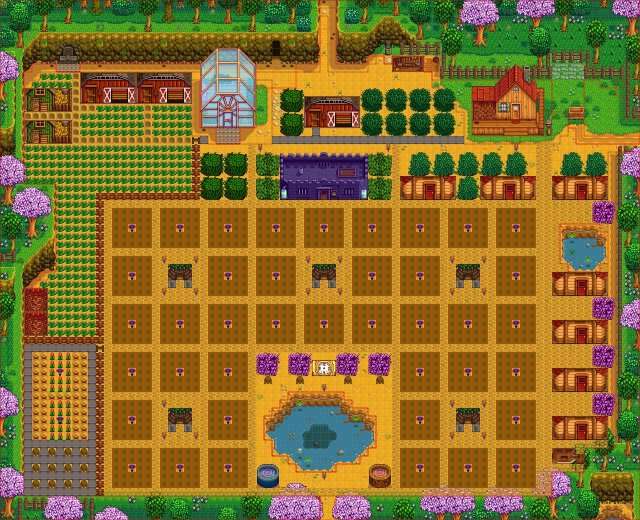
Tiller is the Traditional style of farming that we all think of when we think farming, with this you specialize the farm for maximum crop growth space, using buildings like the shed to maximize crop space whilst still allowing you the room to spec into Artisan Tiller through the use of Preserves and Kegs to further increase the fruits of your labour.
Rancher
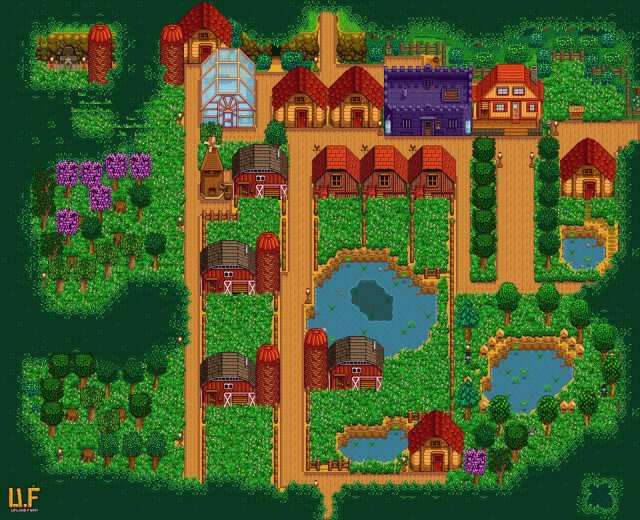
So, you like animals huh? Well rancher is for you, with this you will use the space on your farm to keep animals, with buildings like Coop, Barn and Silo, with this you’ll have a farm bustling with Livestock and you’ll get to pet them everyday and get some good rewards for it, plus using tools like the Mayo Machine, Cheese Press, Loom and Oil Maker you can turn your Animal Produce into Artisan Goods.
Beekeeper
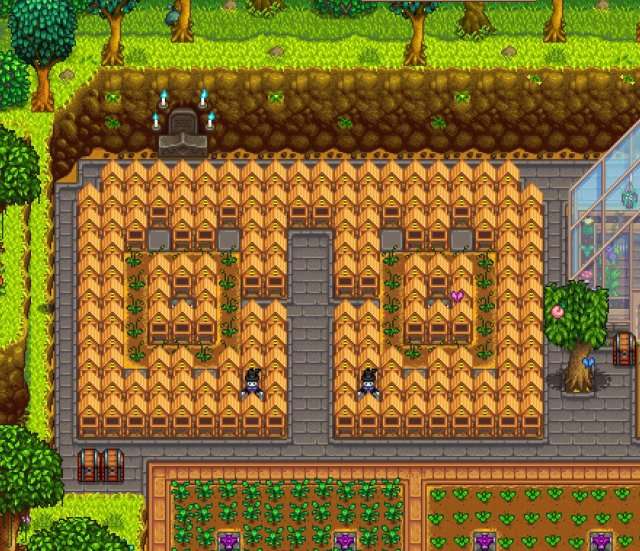
Lets save the bees by turning our farm into a hub for them, and the benefits of farming for bees is massive, large scale bee farm operations net you a lot of cash and they are easy to maintain meaning you have tons of free time to focus other professions.
Moving Onwards
We’ll come back to these farm plans and what the best build in the skill tree is for each later, for now enjoy the pretty images and think about which one you want to aim for and how you want your farm to look, also don’t forget to future proof your farm, stuff like making your paths two blocks wide for when you get a stable and saving space for buildings especially stuff you might neglect like the Well and Extra Silos if you’re a Rancher.
Summer
Summer is the money maker, you get lots of money from farming in summer, you’re gonna want to plant a lot of stuff, using the money you start the month with you’ll want to buy as many blueberries as you can this will make the bulk of your money for summer and when you start making money from this you can keep up the blueberry farm whilst also planting and growing other items, I recommend Pepper and Melon especially Melon as you can plant it in a 3×3 patter to get a chance at Giant Crop, its worth overlapping the Melons as each 3×3 has a chance to spawn so the more chances the better
Fall
My favourite of the seasons, with the massive bank you’ve made up over Summer you should be doing well for yourself, at this point its time to think about getting the farm into shape using the money you’ll want to set yourself up with some Cranberries to start getting the income from those, with any money left over you’ll want to start buying buildings that you need or want depending on your specialisation most importantly a stable and a coop or barn
Tools of the Trade
As a farmer you use both a Hoe and Watering Can, until you get Sprinklers the Watering Can is your go to, you’ll want to aim to upgrade that during the summer when you’ve got some money to play with, the Hoe isn’t a priority to upgrade but if you have the extra cash laying around it might be worth it, I generally find its better not to spend the money on it though as you only need to use it when you lay down new ground for crops compared to the Watering Can that you will use until you get sprinklers and even then you might still need to use it.
Top of the Crop
This has been talked about slightly in other sections but the crop you chose to plant makes all the difference to your wallet, its safe to say that the trellis crops are your safest bet when planted early due to the value over time they accrue, however once you have a trellis farm running you might ask yourself what else you can plant, so here we go:
Spring
Ironically Spring isn’t great for crops as most of them don’t net you much cash but there are a few of note:
- Strawberries; you won’t be planting these year one but in year two and onwards these are your go too, get as many of these down on day one and you’ll be sitting pretty.
- Coffee Bean; if you can get this from Dust Sprites its basically free gold every 2 days and you can make coffee which is amazing for mine trips.
- Rhubarb; Over double the value of purchase, why wouldn’t you choose this?
- Bean; the other trellis crop and you can plant it during year one, for year one this is your go too as it keeps making value after your first harvest.
- Cauliflower; the single harvest money maker, costs a fair bit but it sells for just under double the value, plus its eligible for Giant Crop and if you’re lucky enough to get that you’re in for some big value.
- Potato; another good money maker, these tubers have a chance to drop double when harvested and that all adds up, two for the price of one why not?
- Kale; not amazing but not terrible, there are better options.
- Garlic; not much to write home about, not worth growing for anything unless you are a rancher and have an Oil Machine, at which point this shoots up into Strawberry tier.
- Blue Jazz; the better of the bee flowers but not worth harvesting, top tier if you’re a beekeeper.
- Tulip; worst spring flower no point in getting this unless you can’t afford Jazz.
Summer
- Red Cabbage; a year two crop but it sells for double its value which is always a plus.
- Blueberries; trellis crop that sells for 50 a berry and each harvest per plant gives 3 berries at minimum with a 2% chance for more at 80g purchase price that’s close to double its value.
- Starfruit; falls just shy of being worth double the value at sale but it can be used to make Wine and Jam and that’s where the money comes from with this one selling at nearly 8 times its value.
- Tomato; a trellis crop that sells for more than it costs, always worth the expense.
- Pepper; not a trellis crop but it regrows, it breaks even with purchase but due to the regrow it makes it worth its value, it also has a small chance to drop more than one pepper.
- Melon; another Giant Crop Boi and boy does this make you money, well worth growing especially in overlapping patters for the Giant Crop chance.
- Radish; not a bad single harvest crop and probably the only good one for summer.
- Corn; this doesn’t seem great at first and it isn’t amazing but it grows for 2 seasons, blueberries will always be better than this but if you want to set up a corn farm to run from Summer to Autumn and you do it from Summer day 1 then it does return some value but otherwise this isn’t worth the investment.
- Wheat; the Parsnip of Summer, not worth it at this point there are better things to grow in summer.
- Hops; good for artisans but before you reach that this isn’t worth growing.
- Poppy; the better bee flower of summer but again don’t harvest these.
- Spangle; not as good as the poppy.
- Sunflower; just terrible not worth it, legit just steals your money.
Fall
- Cranberries; what can I say, I’m a sucker for trellis crops, hard not to be when they return so much value.
- Pumpkin; Giant Crop Gang member, it sells for a lot on its own anyway so well worth growing after your cranberries have made some return profits.
- Grape; a decent fruit to sell on its own and it can be used to make Wines but its below Pumpkin because it can be foraged anyway and why buy and plant something when you can get it for free?
- Artichoke; a year 2 crop that sells for quite a lot, a good crop.
- Beet; second verse same as the first, this is a desert crop so it’s a bit harder to get but still returns good value.
- Amaranth; a good choice but not amazing.
- Eggplant; again it will give you a good return but not as much as other crops.
- Yam; I always end up repeating myself as I get further down these lists, I think you get the point, fall is a great season because there isn’t anything you can cut a loss on but there are still good options and worse options.
- Fairy Rose; The one and only best flower for bees but again you shouldn’t be harvesting these, keep ‘em for the bees.
- Bok Choy; not worth growing 0/10.
When to Plant
Always make sure to check how long a crop takes to mature before planting so that you don’t end up wasting money, all the shop crops tell you how long they take to mature, the growth process starts the day after you plant them so taking parsnips as our example if you plant them on day one they take four days to mature so they will be ready on day five.
XP and Levels
Farming XP is gained from harvesting crops and caring for animals: petting, milking and shearing farm animals or picking up animal produce gives you 5 experience points as mentioned in my foraging guide Truffles give foraging rather than farming.
The XP gained from crops depends on the crop and with how many crops there are for sake of convivence know that slower growing and more expensive crops give more XP and crops that drop double only give XP for the first item harvested and no XP for any multiples.
Farming Skill Tree
Level 1
- Scarecrow
- Basic Fertilizer
After 13 Parsnips you get your first level this gives you access to two of the most important items in game the Scarecrow and Basic Fertilizer, Scarecrows keep your crops safe and Fertilizer helps it grow at better quality, both are core items in the farmers tool belt.
Level 2
- Mayonnaise Machine
- Stone Fence
- Sprinkler
Well here we receive our first bit of kit for the Rancher to make his buck and access to the Stone Fence and Sprinkler, the Mayo Machine is well worth it, the sprinkler however isn’t great, we get upgrades for it later so its better to save your materials for those, and Fences are for decoration.
Level 3
- Bee House
- Speed-Gro
- Farmer’s Lunch
Not the BEES, specialization number 3 unlocked Beekeeping is great and a great way to make money easy and the crafting materials are fairly easy to acquire, Speed-Gro is good and Farmers Lunch is useful before Harvest.
Level 4
- Preserves Jar
- Basic Retaining Soil
- Iron Fence
One step closer to the big decision, hope you’ve decided what farm you want to have, Preserves Jars are great for Tillers, Retaining soil is meh, just don’t forget to water your crops, it’s got value if it rains I guess but you still have to check all the crops anyway so no point in my opinion and Iron Fence is decoration.
Level 5
And here we are, you ready to take the big step into dedicating into your farm type, lets go over your options.
Rancher
If you intend to look after animals and use lots of space for Barns and Coops then Rancher is for you, Animal Produce now sells for 20% more which still doesn’t make it sell for as much as crops but you should be turning them into artisan goods anyway, the only real reason I’d pick this one over Tiller is if I was putting a lot of effort into Sheep and we’ll get to that at level 10.
Tiller
Crops now worth 10% more, why not? We can’t turn everything to Artisans Gold so might as well get more value out of that stuff plus the level 10 choices make this even better.
Level 6
- Cheese Press
- Hardwood Fence
- Quality Sprinkler
And we’re back on the grind, but we get some nice rewards, the Rancher gets the Cheese press and the Tiller gets the Quality Sprinkler which is worth building this time!
Level 7
- Loom
- Quality Retaining Soil
Ranchers getting some love again, the Loom is excellent for Ranchers wanting to make the most out of their sheep, Soil is the same again, doesn’t seem worth it to me.
Level 8
- Oil Maker
- Keg
- Deluxe Speed-Gro
Something for everyone in this one, Ranchers get themselves the Oil Maker, however unless you’re playing multiplayer and have someone foraging Pigs aren’t all that worth it even for the Oil, Keg is good news for the Farmer, time to start making real money, and Deluxe Speed-Gro is good for the impatient farmer.
Level 9
- Seed Maker
- Iridium Sprinkler
- Quality Fertilizer
Best Machine, Best Sprinkler and Best Fertelizer, all in one level, the love that crop farmers needed all in one level up.
Level 10
Tiller
Artisan – 40% bonus on artisan goods (except oil) this is an easy choice, Artisan goods already sell for a lot why not get even more money from them? Seems like a no brainer to me.
Agriculturist – Not great, I suppose some might find it useful to have Speed-gro on all their crops for free and I imagine that does add some value but not enough in comparison to the Artisan.
Rancher
Coopmaster – Not great, I don’t see the point in selling my chickens and such off so the incubation time being cut in half isn’t great, granted befriending them quicker is a good advantage but by the time you have this if you don’t sell them off there isn’t much point in this.
Shepherd – Now this one does give value, befriend barn animals faster is useful but it’s the same as the coop for me, however, sheep produce wool faster is amazing, sure its only by one day but sheep grow their coat every 3 days, if your sheep are all 4.5 hearts of friendship that goes down by one, with this perk on top that means they grow their wool every other day, combine this with a Loom and it makes picking the rancher perk worth it.
Specialization
So, I spoke a little about what I think are the three main types of farm in Stardew being; The Farm; The Ranch and the Apiary (or bee farm) now you know more about farming let go a bit more in-depth with them.
The Farm
Crops and Artisan Goods, with this farm your optimal build is Tiller and then Artisan, you want to devote most of the space on your farm to crop growth using fertilizers and scarecrows precisely to maximize crop space and using any space you have left for Sheds to pile in Artisan Crafts like Kegs and Preserve Jars, your end game is having a Greenhouse full of Sweet Gem Berries and a field of seasonal crops being harvested and turned into Jam, Pickles or Wine.
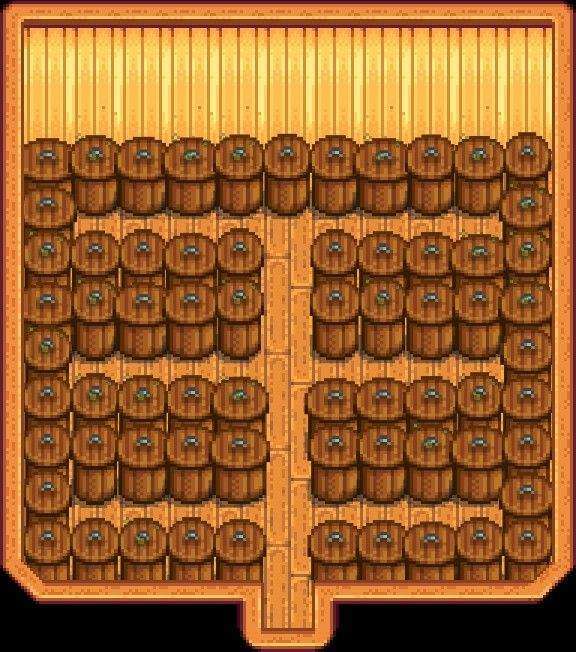
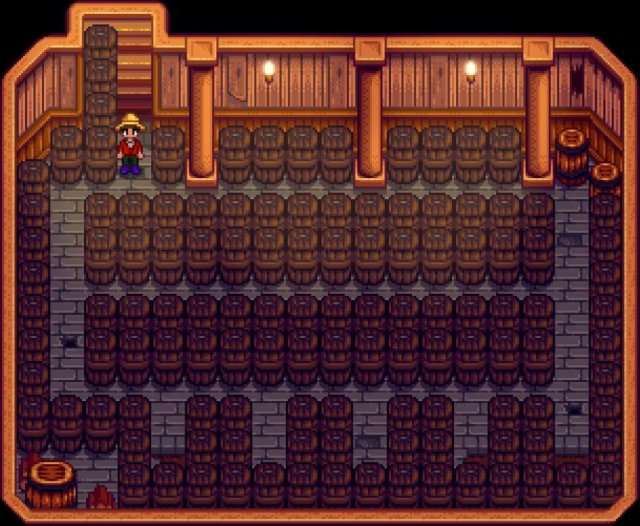
The Rancher
Animals and Produce, with this farm your optimal build is Tiller and then Artisan, or you can follow the Shepherd route and go Rancher then Shepherd, depends on the animal/farm building you want to focus on the most, on your farm you’ll maximize space for Coops and Barns, its best to keep the animals penned in to avoid them being locked outside but be sure to give them plenty of room to move around and for you to grow grass to feed them and save your having to use hay as you’ll want to store it for winter, your end game is to have a farm full of happy animals and machines turning their produce into artisan goods for you to sell.
The Apiary
Beekeeping and Honey Making, with this farm your Optimal Build is Tiller and then Artisan, your farm will maximize getting as many Bee Houses around one flower and still being able to reach the flower for watering and Houses to collect the honey and still having enough room for a scarecrow and if you’re lazy enough a sprinkler for your flower, your end game is to upgrade your house to get Casks and in the Spring sell your Honey Mead, in the Summer and Fall sell your Poppy and Fairy Rose Honey on its own, as mead doesn’t increase the value of your honey your Summer and Fall Honeys sell more than Mead anyway so you want to use Kegs and Casks to improve the sale quality of your Wild Honey and Jazz Honey as they sell for less and the same as Mead but can be aged to sell as much as Poppy Honey and you will always have Wild Honey as none of the flowers (even with modifiers) grow fast enough to produce a Flowered Honey on their first cycle.

Tips and Tricks
- Planting Wheat on the 25th of Summer will allow you to keep tilled and fertilized soil as you go into fall and you’ll be able to clear the wheat for new plants on Fall Day one.
- You don’t need to feed your animals on festival days as they are already considered fed by the game.
- Make sure to cut all remaining grass before fall ends to fill the silo as it will disappear when winter begins.


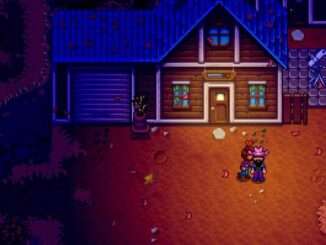


Be the first to comment